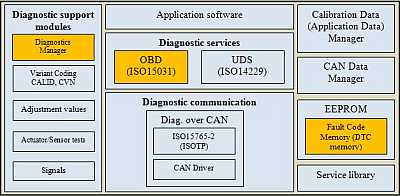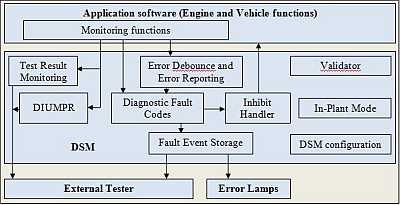- sales@embitel.com
- +91 8041694200


OBD2 Software Development and Testing for an ECU Application
OBD or On-Board Diagnostics refers to a system for emission control which has the capability to detect a malfunction and to store the related information in non-volatile memory. The OBD system monitors the emission relevant components or systems, stores detected malfunctions indicating likely area of malfunction and activates Malfunction Indicator Lamp (MIL) if necessary.
The Objectives of OBD regulation are,
- To improve in-house emission compliance by alerting the vehicle operator when a malfunction exists
- To aid automobile repair technicians in identifying and repairing malfunctioning systems in the emission control system.
OBD diagnostic interface refers to functionally addressed request/response messages to access the OBD relevant information from the vehicle using a generic OBD scan tool.
Requirements
The scope of the project was to design, implement and test OBD-II functionality in an Engine Control Unit. The scope of the project covered the following modules.
- Diagnostic System Manager (Diagnostic Manager and Fault Code Memory) – On board diagnostic functionality to detect and store malfunctions
- OBD Diagnostic Interface – To provide external tester access to stored OBD data

System Overview
DSM – Diagnostic System Manager
The DSM collects the test results reported by the monitoring functions. The current fault states and the derived error memory entries are available in standard form for the application software and the Tester communication.

OBD Diagnostics Interface
This module supports external access to fault code memory and other emission relevant data. A generic OBD scan tool can be connected to the ECU to read emission relevant data. The following Diagnostic services or OBD modes were supported.
- $01 Request current powertrain diagnostic data $02 Request powertrain freeze frame data
- $03 Request emission-related diagnostic trouble codes
- $04 Clear / Reset emission-related diagnostic information
- $06 Request on-board monitoring test results for specific monitored systems
- $07 Request emission-related diagnostic trouble codes detected during current or last completed driving cycle$09 Request vehicle information
Implementation
- Analysis of standard and OEM specific OBD requirement
- Design and development of Fault code memory
- Design and development of Diagnostic manager
- Implementation of OBD services as per ISO15031-5
- Integration of OBD modules with other ECU modules
- Standard QA practices were followed to ensure quality of deliverables
- Standard Testing practices including Unit testing, Integration testing etc
- MISRA compliance
- AUTOSAR architecture is used as reference for development – ensures easy migration to AUTOSAR framework
Tools
- PowerPC controller based ECU
- Trace32 debugger
- SamDia software and HS+ Interface for simulating diagnostic tester
- PC-Lint for static analysis


















